
The Roman buildings in Arles
The Amphitheatre in Arles

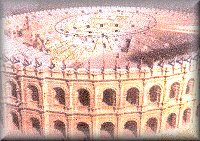 The Roman amphitheatre was built on a little hill in the North of the town in 90 AD. The monument is 136m long and 107m wide, bigger than the one you can see in Nīmes. The external wall is composed of 60 arches and two floors which are 20m high. 20,000 spectators could attend the performances and it would be covered with a Velum fixed on big poles on the front of the theatre.
The picture shows the "Velum" on a model
The Roman amphitheatre was built on a little hill in the North of the town in 90 AD. The monument is 136m long and 107m wide, bigger than the one you can see in Nīmes. The external wall is composed of 60 arches and two floors which are 20m high. 20,000 spectators could attend the performances and it would be covered with a Velum fixed on big poles on the front of the theatre.
The picture shows the "Velum" on a model
It was mainly dedicated to gladiatorial combats. Gladiators were either slaves or people sentenced to death. It was also the place for bloody "shows" to calm down the gods. We know from an inscription in the wall that in the second century AC, Caius Julius Priscus organized a "munus" for the population: it was a gladiatorial combat. After 404 AD, these "games" were abandoned and under the influence of Christianity were replaced by bullfights.
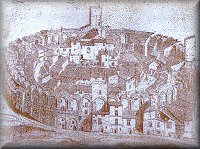 After the fall of the Roman Empire, the monument was occupied by barbarian soldiers and after the destruction of the city, it became the last refuge of the population. Four lookout towers were built; three can still be seen and characterize the monument nowadays. Then, in the middle ages, a little town was settled inside it with more than 210 houses and 2 chapels.
The picture shows the town inside the amphitheatre
After the fall of the Roman Empire, the monument was occupied by barbarian soldiers and after the destruction of the city, it became the last refuge of the population. Four lookout towers were built; three can still be seen and characterize the monument nowadays. Then, in the middle ages, a little town was settled inside it with more than 210 houses and 2 chapels.
The picture shows the town inside the amphitheatre
In 1825, the restoration of the monument began thanks to the Baron de Chartrouse. The first festivity organized in the restored monument took place in July 1830 to commemorate the battle of Algiers.
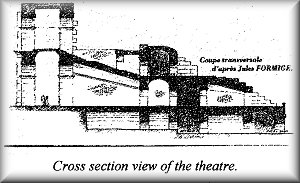 Today, thousands of tourists visit the amphitheatre all year round as well as all the other Roman remains in town. What is really special is that it is still used nowadays for bullfights especially during the "feria"; in Nīmes,a roof has been built so that concerts or other events can take place there. There are also "courses Camargaises" in which bulls are not killed.
Today, thousands of tourists visit the amphitheatre all year round as well as all the other Roman remains in town. What is really special is that it is still used nowadays for bullfights especially during the "feria"; in Nīmes,a roof has been built so that concerts or other events can take place there. There are also "courses Camargaises" in which bulls are not killed.
When we visited the amphitheatre last year, we could go down to the basement where the gladiators got ready and where the beasts where kept in cages; they would appear in the "arena" through a trap door.
The main parts of the monument are:
We can also notice some square notches which were used to support the long wooden beams of the floor.
The Antique Theatre was built in the first century AD. It was 102 metres wide. 10.000 spectators could sit there and it was wonderfully decorated; the two columns in the picture reveal the beauty of the back of the stage.
The Antique Theatre
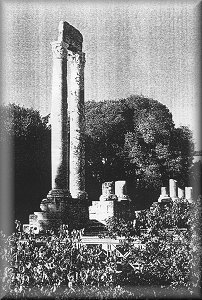
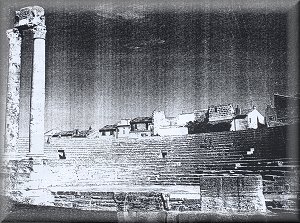
There is a very important restoration project nowadays as the theatre is used for lots of different purposes such as photograph show every year, and plays. A big screen will be installed under the stage and lifted up when used.
During the Roman Empire, the gold age of public baths, the bath establishment was one of the first equipment of the city. It was as important as the temple, the circus and the forum. It was the privileged place for the civic artistic and political life. Luxurious monuments, the Roman baths were among the most complex buildings in Antiquity. They were composed of a succession of pools, the hottest being th "caldarium", the coldest the "frigidarium" and the tepid one called the "tepidarium" and the sauna called "sudarium". Some places were dedicated to healthcare, plucking and physical exercise in the "palestre". Heating and water supply were in the basement rooms. The most famous Roman baths are in Pompeii, Badenweiler, Cartage or Bath (in England).
The Roman Baths in Arles
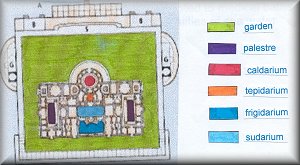
In this tradition, hammams have been kept up to now: the Turkish baths, using the heat of the air and wet steam to favour cleaning by sweating and the Scandinavian saunas which use dry heat, and flogging to stimulate blood circulation. On the contrary, public baths which were the main equipment of popular districts have nearly disappeared because of the generalization of home hygiene. Next to these baths, related to hygiene and entertainment, in Western Europe, medical baths were developed using the qualities of natural waters (called spa waters) to cure nervous, cutaneous, articular or other diseases.
Spa resorts used to be very fashionable in the XVIII and XIX century. They inspired Spa resorts in the second Empire, around building devoted to medical baths = especially those using the qualities of sea water (ex: Marseille).